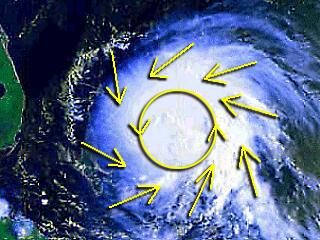Monday, November 12, 2007
Effects Watches and warnings Storm surge - Notable storms Retired hurricanes (Atlantic - Pacific) A tropical cyclone is a meteorological term for a storm system characterized by a low pressure center and thunderstorms that produces strong wind and flooding rain. A tropical cyclone feeds on the heat released when moist air rises and the water vapor it contains condenses. They are fueled by a different heat mechanism than other cyclonic windstorms such as nor'easters, European windstorms, and polar lows, leading to their classification as "warm core" storm systems.
The adjective "tropical" refers to both the geographic origin of these systems, which form almost exclusively in tropical regions of the globe, and their formation in Maritime Tropical air masses. The noun "cyclone" refers to such storms' cyclonic nature, with counterclockwise rotation in the Northern Hemisphere and clockwise rotation in the Southern Hemisphere. Depending on their location and strength, tropical cyclones are referred to by various other names, such as hurricane, typhoon, tropical storm, cyclonic storm, and tropical depression.
While tropical cyclones can produce extremely powerful winds and torrential rain, they are also able to produce high waves and damaging storm surge. They develop over large bodies of warm water, and lose their strength if they move over land. This is the reason coastal regions can receive significant damage from a tropical cyclone, while inland regions are relatively safe from receiving strong winds. Heavy rains, however, can produce significant flooding inland, and storm surges can produce extensive coastal flooding up to 25 mi (40 km) from the coastline. Although their effects on human populations can be devastating, tropical cyclones can also relieve drought conditions. They also carry heat and energy away from the tropics and transport it towards temperate latitudes, which makes them an important part of the global atmospheric circulation mechanism. As a result, tropical cyclones help to maintain equilibrium in the Earth's troposphere, and to maintain a relatively stable and warm temperature worldwide.
Many tropical cyclones develop when the atmospheric conditions around a weak disturbance in the atmosphere are favorable. Others form when other types of cyclones acquire tropical characteristics. Tropical systems are then moved by steering winds in the troposphere; if the conditions remain favorable, the tropical disturbance intensifies, and can even develop an eye. On the other end of the spectrum, if the conditions around the system deteriorate or the tropical cyclone makes landfall, the system weakens and eventually dissipates.
Physical structure
Rainbands are bands of showers and thunderstorms that spiral cyclonically toward the storm center. High wind gusts and heavy downpours often occur in individual rainbands, with relatively calm weather between bands. Tornadoes often form in the rainbands of landfalling tropical cyclones.
Banding
A strong tropical cyclone will harbor an area of sinking air at the center of circulation. If this area is strong enough, it can develop into an eye. Weather in the eye is normally calm and free of clouds, though the sea may be extremely violent.
Eye and inner core
The size of a tropical cyclone is determined by measuring the distance from their center of circulation to their outermost closed isobar. If the radius is less than two degrees of latitude (120 nm, 222 km), then the cyclone is "very small" or a "midget." Radii of 2–3 degrees (120–180 nm, 222–333 km) are considered "small." Radii between 3 and 6 latitude degrees (180–360 nm, 333–666 km) are considered "average sized." Tropical cyclones are considered "large" when the closed isobar radius is 6–8 degrees of latitude (360–480 nm, 666–888 km), while "very large" tropical cyclones have a radius of greater than 8 degrees (480 nm, 888 km). Other methods of determining a tropical cyclone's size include measuring the radius of gale force winds and measuring the radius of the central dense overcast.
Size
A tropical cyclone's primary energy source is the release of the heat of condensation from water vapor condensing at high altitudes, with solar heating being the initial source for evaporation. Therefore, a tropical cyclone can be visualized as a giant vertical heat engine supported by mechanics driven by physical forces such as the rotation and gravity of the Earth.
Mechanics
Blog Archive
-
▼
2007
(104)
-
▼
November
(29)
- Organizational performance comprises the actua...
- Gainesville is the largest city and county seat ...
- Lillian Diana Gish (October 14, 1893 – February ...
- Ferdinand Foch OM GCB (October 2, 1851 – March 2...
- African religions · Atheists Bahá'ís · Buddhists...
- Structures taller than 300 metres Structu...
- The Requiem (from Latin requiem, accusative case...
- The Keelmen of Tyne and Wear were a group of m...
- Élisabeth-Louise Vigée-Le Brun (April 16, 1755...
- Oliver "Ollie" Riedel (b. April 11, 1971) is a G...
- Aire may refer to: In rivers: In towns: In oth...
- Xenokrates of Sicyon (fl. c.280 BC) was a Gree...
- Current members There is one associate member sc...
- Henry Robinson Luce (pronounced like "loose") (A...
- The Queen's Service Order was established by Q...
- The geography of New Zealand encompasses two mai...
- "The Head and the Hair" is the eleventh episo...
- Effects Watches and warnings Storm surge - Notab...
- Zayd al-Khayr is a companion of Muhammad. Hail...
- Percy Sinclair Pilcher (January 1866 — 2 October...
- Deem Reginald Bristow (April 11, 1947 – Januar...
- This article is part of the series: Politics and...
- The London Assembly is an elected body, part o...
- This article is on the diocese of the Scottish...
- The Downtown Halifax Link system is similar to...
- Jack MacDonald Coleman (born February 21, 1958 a...
- Limnology (from Greek: Λίμνη limne, "lake"; an...
- The London Oratory School is a Catholic voluntar...
- The Trecento was a period of vigorous activity i...
-
▼
November
(29)
 Coriolis effect
Coriolis effect
No comments:
Post a Comment